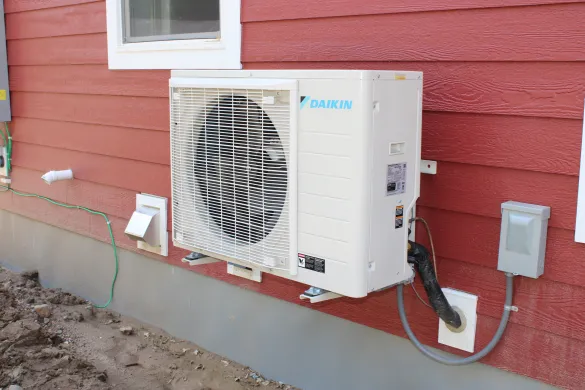
Center for Energy and Environment (CEE) and the Minnesota ASHP Collaborative, alongside community partner Twin Cities Habitat for Humanity (TCHFH), received an EPA grant to increase the adoption of cold climate air source heat pumps (ASHPs) in new and existing homes. By better understanding the up-front costs, design challenges, and market potential of pairing ASHPs with ducted furnace systems, this initiative aims to accelerate decarbonization through the electrification of space heating.
Project Background
Beginning in August 2022, CEE, MN ASHP Collaborative, and TCHFH developed a plan for energy modeling and HVAC system design of a new home. While TCHFH consistently builds airtight homes, they had not yet incorporated ASHPs into their home designs. Based on TCHFH’s interest in building energy efficient homes, CEE helped familiarize TCHFH with ASHPs and identified scenarios where they could use ASHPS to electrify and decarbonize their homes.
This case study highlights how an ASHP can effectively pair with a 96% efficient ducted gas furnace to increase heating efficiency, while adding a source of efficient cooling. In this dual fuel setup, an ASHP, which is more efficient than a natural gas furnace, can be used as the primary heating and cooling system throughout most of the year. These gains in efficiency and electrification are projected to provide substantial energy savings and opportunities for decarbonization.
Plan Review, Consulting, and Multi-phase Testing
Prior to construction, TCHFH and CEE reviewed building plans to ensure alignment on the inspection and testing schedule as well as certification goals and requirements. By performing in-depth analysis and on-site testing of this new home throughout the building process, the review team was able to better understand the up-front costs and ongoing operational costs of pairing an electric ASHP with a high efficiency natural gas furnace as backup heating.
In October 2022, CEE conducted an initial on-site inspection to ensure all new construction framing requirements met Energy Star, Indoor airPLUS, and Zero Energy Ready Home program criteria. CEE also collected size, placement, and performance data for each window and discussed the future installation of the ASHP with the TCHFH project manager. TCHFH new construction projects do not usually include air conditioning systems, so outdoor compressor placement and installation best practices were reviewed, including plans for HVAC sequencing and coordinating with HVAC representatives to assess rough in work.
After TCHFH installed insulation and roughed-in ductwork, CEE completed a second on-site inspection to grade all cavity insulation and ductwork prior to drywall installation while inspecting air and vapor barriers to ensure a continuous airtight assembly. Once the drywall was installed, CEE revisited the site to perform blower door and duct testing to help TCHFH identify leakage points to be sealed before becoming inaccessible and to ensure the building was on track to meet certification requirements.
The airtightness test and infrared imaging also helped inform best practice guidance to TCHFH and the HVAC installers for future projects. CEE then sent each of them an inspection report detailing test results and advising on any corrective actions to meet certification requirements and improve energy performance.
Final Testing
In May 2023, CEE staff completed final performance testing, data collection, and energy modeling on the newly constructed home. The results of this testing will allow this home to qualify for Energy Star, Indoor Air Plus, and Zero Energy Ready certifications. Performance testing included blower door and duct leakage airtightness testing, air handler static pressure measurement, bedroom pressure balancing, hot water delivery performance testing, whole home ventilation testing, and local mechanical exhaust testing.
CEE then collected data on all appliances and mechanical systems and inspected insulation, ducting, ventilation, and radon mitigation system settings. CEE staff also inspected the installed heat pump and verified the system configuration. This data was then entered into energy modeling software to provide updated projections and recommendations. Certification paperwork for Energy Star, Indoor airPLUS, and Zero Energy Ready Homes was later completed and delivered to TCHFH.
Heat Pump Bidding Process
Many builders, such as TCHFH, face difficulties identifying the scope of work and finding installation contractors familiar with modern ASHP system design. To overcome this barrier, electric utilities and third-party organizations, such as the MN ASHP Collaborative, offer resources to connect builders with HVAC contractors who demonstrate expertise and quality installation of heat pumps in Minnesota. Since TCHFH was interested in electrification but not familiar with ASHPs, they needed guidance on heat pump selections, operating cost estimates from prior modeling work, and evaluation of bids from contractors.
Led by TCHFH and in collaboration with the electric utility, Xcel Energy, CEE provided program resources developed through the MN ASHP Collaborative1 for useful context and information to help evaluate bids and have conversations with HVAC contractors. CEE also reviewed and provided input on bid selection and worked with TCHFH to create a bid specification template for future ASHP projects.
Energy Modeling to Estimate Homeowner Costs
CEE used Ekotrope software to model the annual energy costs of the home as-built with and without solar panels to show the potential to lower electricity bills through solar offsets. These models were also compared to the home as-built with a 14 SEER central air conditioner in place of the ASHP. The modeling team chose to show the air conditioner baseline scenario even though TCHFH does not typically install them because homeowners often install these types of air conditioners after purchasing the home, often choosing a less expensive and less energy efficient 14 SEER (Seasonal Energy Efficiency Ratio) option.
CEE also modeled a home constructed to meet minimum code requirements versus a typical TCHFH home, which is significantly more airtight and energy efficient than code requires. This enables their homes to be especially good candidates for the ASHP dual fuel setup, since these systems perform better in airtight homes. An important finding to note is that the dual fuel ASHP setup does increase annual heating costs when compared to a gas furnace alone, at current electric and natural gas prices. Xcel Energy offers a dual fuel electric rate at a slight discount below the standard rate. However, the rate requires the installation of a second, separate meter at a high cost. These economics are challenging to overcome.
In areas where electric utilities do offer this type of rate, economics can be significantly improved for a homeowner by ensuring that ASHPs are installed with appropriate metering equipment and enrolled in these programs. In this case, a solar array installed on the home will greatly reduce electric costs, so the homeowner will not see increased electric bills from the ASHP. Beyond first-year costs, another key consideration is that a dual fuel ASHP offers fuel flexibility and resilience to potential volatility in the natural gas market. With an ASHP, the homeowner can adjust the system’s switchover temperature in the future to optimize savings as fuel prices change over the lifetime of the equipment.
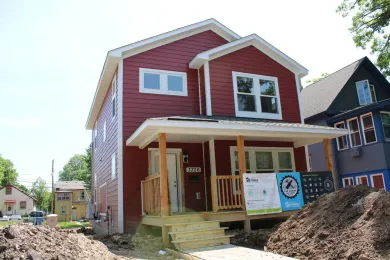
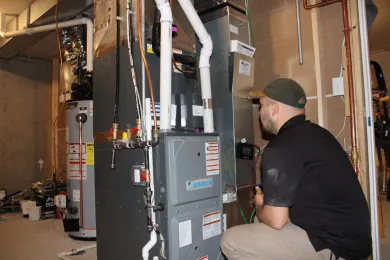
Electrification and Carbon Emissions
The electrification work done on the home is projected to increase first-year carbon emissions due to the emissions from increased electric use. However, over the lifetime of the equipment, emissions are projected to decrease below baseline levels as Minnesota transitions to 100% carbon-free electricity by 2040. A detailed breakdown of energy consumption and energy costs by end use is below.
Energy Consumption Breakdown by End Use
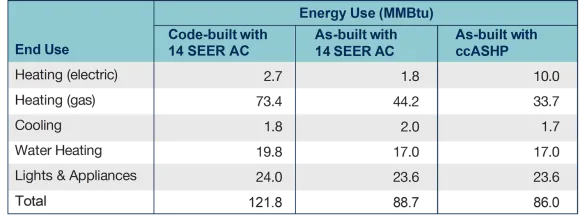
Cost Breakdown by End Use
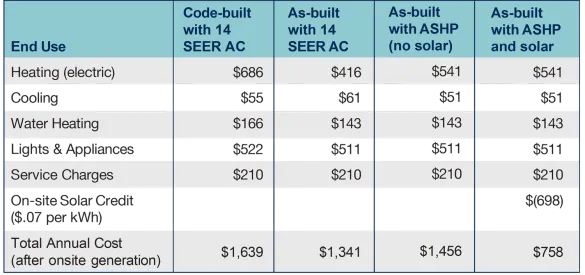
Total Emissions:

Electric Rates assumptions: In all scenarios, electric use was modeled using a seasonally weighted average of Xcel Energy’s standard residential electric rate ($0.8803/kWh, $0.10301/kWh June-September). Natural gas use was modeled using CenterPoint Energy’s residential gas rate, including the base cost of gas and gas distribution charge. These rates do not include applicable riders and taxes, which can increase monthly volumetric charges.
Solar Rewards credit: This property qualifies for a production-based incentive of $0.07 per kWh based on eligibility as an income-qualified Solar Rewards customer. This rate is multiplied by the total solar production and credited back to the homeowner annually. Additionally, the customer would receive an up-front incentive of $2.00 per Watt, accounting for approximately $16,000, to help offset the cost of the installed system.
Key Takeaways
- Designing and building an airtight home lowers heating and cooling loads, making it more advantageous to use an ASHP as a primary heating and cooling source in a dual fuel system. In addition, lowering the heating and cooling loads decreases the size of equipment needed, which can further reduce costs.
- Favorable dual fuel rates, utility rebates, and tax incentives (such as 25C ASHP Tax Credit and 45L Tax Credits) allow ASHPs to be more cost-effective while achieving electrification and carbon reduction goals.
- An ASHP can efficiently deliver heating and cooling on all but the coldest few days of the year when paired with a ducted gas furnace as backup heat in a dual fuel setup.
- Electric utilities and third-party organizations provide useful resources and guidance to homeowners and builders through the HVAC contractor selection and bidding process.
- Certified raters and inspectors can review plans, perform energy modeling, and provide on-site inspection to inform ASHP design and selection while ensuring that the home is energy efficient and achieves desired certifications.
- HVAC contractors can work directly with distributors to get equipment and training support for high-quality installation of heat pumps in our climate.
Habitat New Home Energy Audit Profile
- Where: Minneapolis, MN
-
Built: 2023
Size: 2240 ft²
Number of Bedrooms: 5
- House Type: Two-story
- Primary Heating System: Dual Fuel HeatPump:2.5tons,variable-speed, 16.6 SEER2, 8.2 HSPF2, 1.99 rated COP @ 5°F
- Capacity Balance Point: 9°F
- Heating Design Load: 25.4k Btu/hour (at -11°F)
- Cooling Design Load: 12.32k Btu/ hour (at 89°F)
- Secondary Heating System: 96% efficient natural gas furnace (switch over at 35°F)
- Water Heating: Residential Water Heater • Natural Gas • 0.72 UEF
- House Tightness: 457 CFM50 (or 1.22 ACH50)
- Ventilation: 74 CFM • 39 Watts • HRV
- Duct Leakage to Outside: 16 CFM @ 25Pa (0.63 / 100ft2)
- Insulation: R50 (attic), R24 (sidewalls), and R10 (foundation and slab) Window Efficiency: U-Value: 0.3,
- SHGC: 0.31
- Energy Efficient Lighting: 100%
- HERS Model Score: 16 (projected with solar) vs. 45 (projected without solar)
- ZERH Target Score: 53
- Annual Savings Projected: $526 (relative to average new home constructed to MN code requirements)
- Certifications: Energy Star, Indoor airPLUS, Zero Energy Ready Home
- Utility Rebates: $500–$800 for ASHP and $500 for heat pump water heater dependent on HSPF rating and quality installation by a registered contractor
Appendix
Northeast Energy Efficiency Partnerships (NEEP)
The NEEP cold climate ASHP product list can be used to look up extended performance data for ASHPs that can operate efficiently in cold climates. The tool also allows users to visualize heat pump performance data and find a heat pump’s capacity balance point in the Sizing for Heating tool using local weather data if heating design temperature and design load are known.
• Size for Heating User Guide provides detailed instructions for using the Sizing for Heating tool.
• Guide to Sizing & Selecting ASHPs in Cold Climates provides information on sizing and selecting ASHPs for different application types in cold climates.
The Minnesota ASHP Collaborative was formed in 2019 by Center for Energy and Environment and is a joint effort with Minnesota Utilities to promote ASHP adoption across Minnesota. We offer several resources that can be leveraged by builders looking to include ASHPs in homes they construct.
• Installation Best Practices Guide
• Cost of Heat Comparison tool models annual energy costs with various heat pump configurations for both natural gas and propane systems across several Minnesota utilities.
• Specification Summary Guide can be used to compare different ASHP equipment specifications. This can be useful during product selection to maximize available incentive funding.
• Online Trainings Modules cover heat pump potential in MN, heat pump sizing and selection, and installation best practices.
• Incentives and Financing lists available rebates and incentives for ASHPs in MN.
• Preferred Contractor Network lists contractors that have completed required training, undergone review of an ASHP installation to verify alignment with best practices, and are properly insured.
The Building Science Education Center provides many free resources and on-demand trainings on ASHPs.
• Introduction to Heat Pumps is an introductory training module on the basics of ASHPs.
• Smart Diagnostic Tools provides resources for high-quality installation of HVAC systems.